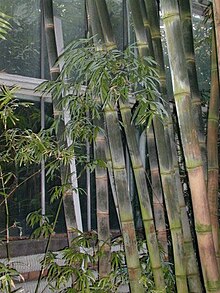Dendrocalamus
| Dendrocalamus | |
|---|---|

| |
| Dendrocalamus spp. | |
| Scientific classification | |
| Kingdom: | |
| (unranked): | |
| (unranked): | |
| (unranked): | |
| Order: | |
| Family: | |
| Subfamily: | |
| Supertribe: | |
| Tribe: | |
| Subtribe: | |
| Genus: | Dendrocalamus |
Dendrocalamus is a tropical genus of giant clumping bamboo, which are similar to the genus Bambusa. With about 29 species, this genus is found from the China throughout Southeast Asia. Dendrocalamus giganteus is one of the tallest of bamboos, capable of reaching heights up to 46 m.[1][2]
Species
- D. asper
- D. bogar
- D. brandisii
- D. giganteus
- D. grandis
- D. hamiltonii
- D. latiflorus Munro - Taiwanese giant bamboo (Chinese: 麻竹; pinyin: mázhú; Wade–Giles: ma-chu); source of food product known generally in Japan as menma (メンマ, 麺麻、麺碼) used foremost as ramen condiment, and in China known variously as "shredded bamboo shoots" (Chinese: 筍絲; pinyin: sǔnsī; Wade–Giles: sun-ssu) etc., depending on the processed product.
- D. jianshuiensis
- D. minor
- D. sikkimensis
- D. strictus - phai sang (Thai: ไผ่ซาง) — Male Bamboo, Calcutta Bamboo
- D. xishuangbannaensis
- D. yunnanica
Taxonomy

The following taxa have been brought into synonymy with Dendrocalamus:
- Klemachloa R.Parker
- Oreobambos K.Schum. - a monotypic genus, sometimes also stands alone
- Oxynanthera
- Sinocalamus McClure
Bodoland
References
Dendrocalamus copelandii • Synonyms: Bambusa cope¬landii, Dendro¬calamopsis cope¬landii, Sino¬calamus cope¬landii. • Thai names: ไผ่มันหมู (phai man mu), ไผ่หกน้ำ (phai hok nam), ไผ่เป๊าะ (phai po). Phai man mu (man = fat; mu = pig, pork) alludes to the copious amount of wax of the inter¬nodes. The name phai po is applied to other species, too. • Distribution: THAILAND: western and northern part: Kanchanaburi, Mae Hong Son, and Tak provinces, in mixed deciduous forest and dry evergreen forest; BURMA: northern part (native); INDIA (cultivated). • Culm size: Height 15 - 30 m, diameter 8 - 25 cm. This size is recorded from plants in Kanchanaburi populations, and the diameter of 25 cm was verified. Plants in Mae Hong Son populations are known only of considerably smaller maximum size both in height and diameter. • Descriptions: (1) "A large, elegant, tufted bamboo. Culms up to 20 m tall, 16-19 cm in diameter at the base, walls fairly thick at the base; nodes hardly prominent; internodes upto 45 cm long on robust culms, when young covered with appressed silvery hairs. Culm-sheaths 38 cm long and 30 cm broad at the base, thick, covered with scanty golden-yellow hairs outside, polished inside, top rounded towards the short and narrow blade. Blade and edge of sheath in young shoots very sharp, copper coloured; auricles absent or minute. Leaves 33-38 cm long and 4.5-8 cm broad, ovate-lanceolate, rounded at the base, almost smooth and glabrous above, softly hairy and scabrous beneath, secondary nerves quite prominent, transverse veinlets visible on the lower surface. ..." —
